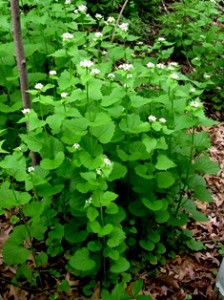What you don’t know can hurt you. In the case of garlic mustard (Alliaria petiolata) it can hurt your woodland too – badly. My awareness of more and larger infestations of garlic mustard every spring hurts my ability to sleep well for several nights. Doctor, doctor – please increase my meds!
Garlic mustard is worse than buckthorn in terms of its rating as a noxious weed. The Department of Agriculture sets our noxious weed policy in Minnesota. Buckthorn is a restricted noxious weed; garlic mustard is a prohibited noxious weed. Prohibited noxious weeds (garlic mustard) must be controlled or eradicated per state law. Enforcement measures may be limited as some of the largest infestations of garlic mustard are on government-owned property. Hmmm, another law with no teeth? Sorry, I digress.
Garlic mustard is a biennial plant that was brought to the United States by European settlers in the mid-1800s. It was valued in its native region as a flavorful herb high in vitamins A and C, as a medicinal treatment for gangrene and ulcers and as a form of erosion control. Within its native European habitat, over 30 natural controls such as insects and herbivores keep garlic mustard in check. As an alien species in North America garlic mustard has NO natural enemies allowing its uncontrolled and rapid spread. (See why I tell you to plant native plants of local origin!)
What makes garlic mustard so horrible to our natural environment? Well children, gather ‘round and let me tell you a little woodland story. Once upon a time, a garlic mustard seed escaped captivity by clinging to the moist soil on a deer hoof and came to live in my woodland. It wasn’t deterred by the health and diversity of my native plant species. It was almost has happy to set up shop in my healthy woodland as a site with poor and disturbed soil.
The garlic mustard seed secretly germinated one year. The following spring it grew bigger and produced a stalk with blossoming clusters of 4-petaled white flowers. The tiny green pods that followed housed up to 1500+ new seeds. The drying pods burst open and dispersed their seed in a 10’ radius. That single little seed had finished its mission in life leaving behind a bumper crop of new seeds to carry on.
Try to get some sleep now and stop by later for the next chapter.
Cheryl
Landscape Restoration, Inc.



